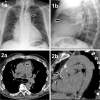Effect of routine preoperative screening for aortic calcifications using noncontrast computed tomography on stroke rate in cardiac surgery: the randomized controlled CRICKET study
- PMID: 34783875
- PMCID: PMC8921026
- DOI: 10.1007/s00330-021-08360-4
Effect of routine preoperative screening for aortic calcifications using noncontrast computed tomography on stroke rate in cardiac surgery: the randomized controlled CRICKET study
Abstract
Objectives: To evaluate if routine screening for aortic calcification using unenhanced CT lowers the risk of stroke and alters the surgical approach in patients undergoing general cardiac surgery compared with standard of care (SoC).
Methods: In this prospective, multicenter, randomized controlled trial, adult patients scheduled for cardiac surgery from September 2014 to October 2019 were randomized 1:1 into two groups: SoC alone, including chest radiography, vs. SoC plus preoperative noncontrast CT. The primary endpoint was in-hospital perioperative stroke. Secondary endpoints were preoperative change of the surgical approach, in-hospital mortality, and postoperative delirium. The trial was halted halfway for expected futility, as the conditional power analysis showed a chance < 1% of finding the hypothesized effect.
Results: A total of 862 patients were evaluated (SoC-group: 433 patients (66 ± 11 years; 74.1% male) vs. SoC + CT-group: 429 patients (66 ± 10 years; 69.9% male)). The perioperative stroke rate (SoC + CT: 2.1%, 9/429 vs. SoC: 1.2%, 5/433, p = 0.27) and rate of changed surgical approach (SoC + CT: 4.0% (17/429) vs. SoC: 2.8% (12/433, p = 0.35) did not differ between groups. In-hospital mortality and postoperative delirium were comparable between groups. In the SoC + CT group, aortic calcification was observed on CT in the ascending aorta in 28% (108/380) and in the aortic arch in 70% (265/379).
Conclusions: Preoperative noncontrast CT in cardiac surgery candidates did not influence the surgical approach nor the incidence of perioperative stroke compared with standard of care. Aortic calcification is a frequent finding on the CT scan in these patients but results in major surgical alterations to prevent stroke in only few patients.
Key points: • Aortic calcification is a frequent finding on noncontrast computed tomography prior to cardiac surgery. • Routine use of noncontrast computed tomography does not often lead to a change of the surgical approach, when compared to standard of care. • No effect was observed on perioperative stroke after cardiac surgery when using routine noncontrast computed tomography screening on top of standard of care.
Keywords: Cardiac surgical procedures; Preoperative care; Radiography; Stroke; Tomography, X-ray computed.
© 2021. The Author(s).
Conflict of interest statement
The authors of this manuscript declare relationships with the following companies: The Department of Radiology, UMCU receives research support from Philips Healthcare and the Department of Radiology, Erasmus MC receives institutional support from Siemens, both outside the submitted work. Dr. Merkely reports grants from Boston Scientific, grants and personal fees from Medtronic and Abbott, personal fees from Biotronik, outside the submitted work.
Figures



Similar articles
-
Incidental findings on routine preoperative noncontrast chest computed tomography and chest radiography prior to cardiac surgery in the multicenter randomized controlled CRICKET study.Eur Radiol. 2023 Jan;33(1):294-301. doi: 10.1007/s00330-022-09001-0. Epub 2022 Jul 19. Eur Radiol. 2023. PMID: 35852576 Free PMC article. Clinical Trial.
-
Ultra low-dose chest ct with iterative reconstructions as an alternative to conventional chest x-ray prior to heart surgery (CRICKET study): Rationale and design of a multicenter randomized trial.J Cardiovasc Comput Tomogr. 2016 May-Jun;10(3):242-5. doi: 10.1016/j.jcct.2016.01.016. Epub 2016 Jan 30. J Cardiovasc Comput Tomogr. 2016. PMID: 26857421 Clinical Trial.
-
Who needs preoperative routine chest computed tomography for prevention of stroke in cardiac surgery?Interact Cardiovasc Thorac Surg. 2010 Jul;11(1):30-3. doi: 10.1510/icvts.2009.231761. Epub 2010 Apr 1. Interact Cardiovasc Thorac Surg. 2010. PMID: 20360209
-
Effect of computed tomography before cardiac surgery on surgical strategy, mortality and stroke.Eur J Radiol. 2016 Apr;85(4):744-50. doi: 10.1016/j.ejrad.2016.01.003. Epub 2016 Jan 14. Eur J Radiol. 2016. PMID: 26971418 Review.
-
Preoperative Nonselective Chest Computed Tomography Prior to Primary Cardiac Surgery Results in Meaningful Change to Surgical Management: Systematic Review and Pooled Prevalence Meta-Analysis.Heart Lung Circ. 2024 Sep;33(9):1250-1258. doi: 10.1016/j.hlc.2024.04.302. Epub 2024 Jul 8. Heart Lung Circ. 2024. PMID: 38981829
Cited by
-
Incidental findings on routine preoperative noncontrast chest computed tomography and chest radiography prior to cardiac surgery in the multicenter randomized controlled CRICKET study.Eur Radiol. 2023 Jan;33(1):294-301. doi: 10.1007/s00330-022-09001-0. Epub 2022 Jul 19. Eur Radiol. 2023. PMID: 35852576 Free PMC article. Clinical Trial.
-
Multivessel Coronary Disease and Severe Atherosclerotic Aorta: Real-World Experience.Medicina (Kaunas). 2023 Nov 2;59(11):1943. doi: 10.3390/medicina59111943. Medicina (Kaunas). 2023. PMID: 38003992 Free PMC article.
-
Thoracic aortic calcifications on chest radiographs and incident major adverse limb events in cardiovascular disease patients.Int J Cardiovasc Imaging. 2025 Jul;41(7):1437-1444. doi: 10.1007/s10554-025-03435-5. Epub 2025 Jun 2. Int J Cardiovasc Imaging. 2025. PMID: 40456981 Free PMC article.
References
Publication types
MeSH terms
Grants and funding
LinkOut - more resources
Full Text Sources
Medical

